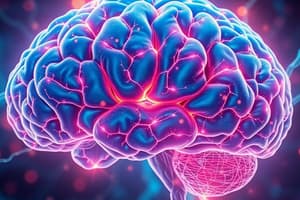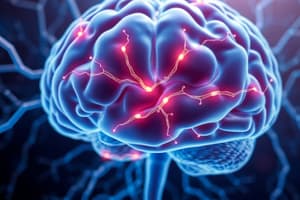Podcast
Questions and Answers
Which of the following best describes the action of an agonist?
Which of the following best describes the action of an agonist?
- It inhibits the reuptake of a neurotransmitter.
- It decreases the production of a neurotransmitter.
- It blocks the receptor site of a neurotransmitter.
- It increases the action of a neurotransmitter. (correct)
What is the primary mechanism of action of cocaine?
What is the primary mechanism of action of cocaine?
- Acting as an antagonist for dopamine.
- Blocking the reuptake of neurotransmitters. (correct)
- Increasing the metabolism of neurotransmitters.
- Stimulating the release of norepinephrine.
Which neurotransmitter's action is mimicked by opioids?
Which neurotransmitter's action is mimicked by opioids?
- Norepinephrine
- Endorphins (correct)
- Serotonin
- Dopamine
In Parkinson's disease, administering L-dopa aims to:
In Parkinson's disease, administering L-dopa aims to:
An excess of which neurotransmitter is most directly associated with the euphoria caused by cocaine and amphetamines?
An excess of which neurotransmitter is most directly associated with the euphoria caused by cocaine and amphetamines?
What is a key difference between morphine and endorphins?
What is a key difference between morphine and endorphins?
Which of these best describes the combined action of amphetamines in the synapse?
Which of these best describes the combined action of amphetamines in the synapse?
What is the potential consequence of an overdose of amphetamine or cocaine due to their effect on the heart?
What is the potential consequence of an overdose of amphetamine or cocaine due to their effect on the heart?
Which neurotransmitter's reuptake is primarily blocked by Prozac?
Which neurotransmitter's reuptake is primarily blocked by Prozac?
What is the main function of naloxone when dealing with opioid overdose?
What is the main function of naloxone when dealing with opioid overdose?
Which area of the brain is responsible for directly regulating body temperature, hunger, and thirst?
Which area of the brain is responsible for directly regulating body temperature, hunger, and thirst?
What is the primary function of the hippocampus in the context of memory?
What is the primary function of the hippocampus in the context of memory?
Which part of the limbic system is most directly involved in the formation of emotional memories?
Which part of the limbic system is most directly involved in the formation of emotional memories?
What is the key function of the basal ganglia?
What is the key function of the basal ganglia?
What is the main cause of the tremors and movement difficulties associated with Parkinson's disease?
What is the main cause of the tremors and movement difficulties associated with Parkinson's disease?
What is the primary function of the endocrine system?
What is the primary function of the endocrine system?
Which gland is often called the 'master gland' of the endocrine system?
Which gland is often called the 'master gland' of the endocrine system?
What is the primary role of the pineal gland?
What is the primary role of the pineal gland?
What is the main function of the adrenal glands?
What is the main function of the adrenal glands?
Which statement best describes how the hypothalamus interacts with the pituitary gland?
Which statement best describes how the hypothalamus interacts with the pituitary gland?
Which of the following is a characteristic of opioid drugs?
Which of the following is a characteristic of opioid drugs?
What would be a typical result of damage to the hippocampus?
What would be a typical result of damage to the hippocampus?
How do the endocrine and nervous systems interact to regulate behavior?
How do the endocrine and nervous systems interact to regulate behavior?
Flashcards
Endorphins
Endorphins
Chemicals that act on the pain pathways and emotion centers of the brain and are involved in regulating mood, pain, and pleasure.
Agonists
Agonists
Drugs that increase the activity of a neurotransmitter by either promoting its release or mimicking its effects.
Antagonists
Antagonists
Drugs that decrease the activity of a neurotransmitter by either blocking its release or preventing its binding to receptors.
L-Dopa Drug
L-Dopa Drug
Signup and view all the flashcards
Amphetamine
Amphetamine
Signup and view all the flashcards
Cocaine
Cocaine
Signup and view all the flashcards
Opioids
Opioids
Signup and view all the flashcards
Stimulant Overdose
Stimulant Overdose
Signup and view all the flashcards
Opioid antagonist
Opioid antagonist
Signup and view all the flashcards
Naloxone mechanism of action
Naloxone mechanism of action
Signup and view all the flashcards
How Prozac works
How Prozac works
Signup and view all the flashcards
Selective Serotonin Reuptake Inhibitor (SSRI)
Selective Serotonin Reuptake Inhibitor (SSRI)
Signup and view all the flashcards
What is the hypothalamus?
What is the hypothalamus?
Signup and view all the flashcards
Functions of the hypothalamus
Functions of the hypothalamus
Signup and view all the flashcards
What is the limbic system?
What is the limbic system?
Signup and view all the flashcards
Role of the hippocampus
Role of the hippocampus
Signup and view all the flashcards
Effects of hippocampus damage
Effects of hippocampus damage
Signup and view all the flashcards
What is the amygdala?
What is the amygdala?
Signup and view all the flashcards
Function of the amygdala
Function of the amygdala
Signup and view all the flashcards
Amygdala's role in memory
Amygdala's role in memory
Signup and view all the flashcards
What are the basal ganglia?
What are the basal ganglia?
Signup and view all the flashcards
Function of the basal ganglia
Function of the basal ganglia
Signup and view all the flashcards
Study Notes
Neurotransmitters and Drugs
- Endorphins: Chemicals within brain pain pathways and emotion centers; morphine mimics their effects. Runner's high is an example of endorphin release.
- Agonists: Drugs increasing neurotransmitter action.
- Antagonists: Drugs decreasing neurotransmitter function.
- Drugs can alter neurotransmitter production or release, or mimic neurotransmitters' chemical structure to bind to receptors.
- Parkinson's Disease: Caused by dopamine loss. L-dopa, a dopamine agonist, increases dopamine production, but effectiveness decreases over time.
- Amphetamines: Stimulate norepinephrine and dopamine release, and block their reuptake, causing excess neurotransmitters and activation.
- Cocaine: Prevents neurotransmitter reuptake (norepinephrine and dopamine), leading to euphoria, wakefulness, and energy bursts but also increased heart rate.
- Overdose of amphetamines/cocaine: Can cause rapid heart contractions, potentially leading to fainting and death.
- Opioids: Class of drugs acting as endorphin agonists, inducing calmness and euphoria. Widely prescribed for pain relief; they're also antagonists decreasing pain perception neurotransmitters.
- Opioid overdose: Can lead to asphyxiation and death.
- Naloxone (Narcan): Opioid antagonist, binding to opioid receptors and blocking agonist effects to prevent harmful effects.
- Prozac (SSRI): Serotonin reuptake inhibitor, used in depression treatment.
Brain Structures and Functions
- Hypothalamus: Regulates body temperature, hunger, thirst, and sexual behavior. Essential for maintaining optimal body functions. Lesions can cause overeating or lack of appetite.
- Limbic System: Group of forebrain structures (hypothalamus, hippocampus, and amygdala). Involved in motivation, emotion, learning, and memory. Connection between subcortical structures and cerebral cortex.
- Hippocampus: Critical for creating and storing new memories. Damage results in inability to retain newly acquired information after brief distractions; other memories are unaffected.
- Amygdala: Attached significance to events associated with fear, punishment, or reward; plays role in emotional memory formation, and during emotional arousal it stimulates hippocampus to remember details.
- Basal Ganglia: Set of subcortical structures directing intentional movements. The striatum (part of basal ganglia) controls posture and movement. Damage to parts of the midbrain supplying the striatum with dopamine (as in Parkinson's) impairs striatum function, causing tremors.
- Parkinson's disease symptoms: Uncontrollable shaking and limb jerks, difficulty initiating movements
Endocrine System
- Endocrine System: Network of glands producing hormones influencing bodily functions like metabolism, growth, sexual development; working in close relation with the nervous system, especially the limbic system, to regulate thoughts, emotions, and behaviors.
- Major Glands: Thyroid (regulates body functions), adrenals (stress responses), pancreas (digestion), pineal (melatonin, sleep-wake cycle), and pituitary ("master gland" directing other glands' functions).
- Hypothalamus role: Sends hormonal signals to the pituitary, which directs other glands for functions like stress, digestion, and reproduction.
- Reproductive glands: Ovaries (estrogen) and testes (testosterone) play key roles in sexual behavior and reproduction; not exclusive to one sex.
Studying That Suits You
Use AI to generate personalized quizzes and flashcards to suit your learning preferences.




